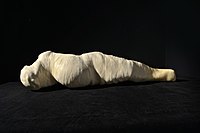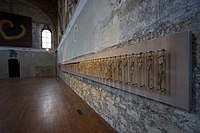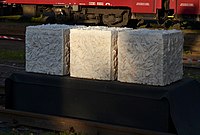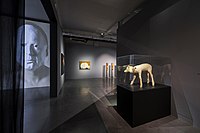Daniel Pešta
Daniel Pešta (born May 1, 1959 in Prague ) is a Czech visual multimedia artist.
Life
Daniel Pešta was born in the family of the architect Antonín Pešta and the psychologist Helena Montanelli-Pešta. He attended a building school and the Václav Hollar School of Fine Arts (Výtvarná škola Václava Hollara) in Prague. During the communist rule he worked in seclusion and was part of the alternative culture. He later made a living as a graphic designer for posters and record covers. After 2000, he abandoned practical art and has since devoted himself exclusively to his free work.
In 1998 and 2000 he completed two study visits to New York. He has been exhibiting in solo exhibitions since 1992. He was represented in various renowned art projects and biennials. The most important to date was his project I was born in your bed, which took place on the occasion of the 55th Venice Biennale in 2013. He then presented himself at the Biennale di Venezia as part of the side projects Personal Structures in Palazzo Bembo (Recordings of a Night Head, 2015) and in Palazzo Mora (Screams picture cycle, 2017). In 2017 Pešta was awarded the 2nd prize for painting at the London Art Biennale. The peak of his work so far was Pešta's extensive solo exhibition DeTermination, which was organized by the DOX Center for Contemporary Art in Prague in 2018.
He is married to the Czech doctor, intellectual and philanthropist Dadja Altenburg-Kohl . His daughter Karolína Peštová-Matoušová, a graduate of art theory at Charles University in Prague, comes from his first marriage to Alena Peštová .
He was a member of the Czech artists' association SVU Mánes, from which he left at the end of 2012.
plant
Before 1989, Daniel Pešta was engaged in graphic design. He designed around 100 covers for classical music records and received awards for his books and posters (1st prize in the Political Poster category, Mexico, 1990). Since the late 80s he has mainly devoted himself to figure and portrait painting. He adopted an easily recognizable personal style early on. He initially applied his drawing skills in hyper-realistic painting. He soon left this, however, and turned to a more expressive, raw language that is closer to his nature.
Daniel Pešta’s art is highly intuitive; it is influenced by social issues and politics and reflects the vulnerability of the individual and the complexity of his inner being. He is not afraid of risks, because the artistic act is also an expression of his radical social and political stance. His works deal with the essence of human existence and the role of humans in global society. Often the subjects have a social or political sub-text that emphasizes the risks of the abuse of power. His typical motif are masks, which he perceives as symbols of disguise or the loss of individual identity. In its multiplied form, the mask forms only a shapeless mass without personal characteristics, without history, in which the person becomes a mere number in statistics.
In 1998 Daniel Pešta completed his first study visit to New York . Contact with the international art scene had a radical influence on his work. In addition to paintings, he also began to create statues and hanging installations. In naturalistic assemblages he experiments with wax, leather, textiles and photos. Since 2004, his favorite material has been semi-transparent epoxy resin, in which he first poured his older pictures and objects, thereby permanently preserving them and at the same time devaluing them. He later used the same technique in extensive photo installations: in the cycle Genetic Codes (I-IV, 2008–2013), in the monumental work Václav Havel's Mills of Time (2011–2016), which is reminiscent of Václav Havel and is permanent in the St. Annen Church in Prague, in a collection of objects on the theme of Ecce Homo (2004–2011) and Christ (2011) and in a series of 21 assemblages Recordings of a Night's Head (2012–2015), which summarize the key themes of his work form. In the notes he combines old and new photographs with painting, woven nets and bizarre objects of unclear origin. Some visions are sharp and present, others misty and forgotten. According to the principles of dream logic, reality and childhood memories merge, and the whole series describes life from birth to adolescence, erotic tension and feelings of fear and guilt up to unfulfilled expectations, fatigue and fear of death.
Video art has also been an important part of his work since 2009 . In the expressive work Narcissus (2010) he uses a mask cast of his own face, which is ultimately eaten as his uncomfortable and restrictive “alter ego”. A similar video entitled The Scream (2010), which is part of a whole collection of works on the topic of the limit states of human existence, ends with the symbolic sewing of the mouth. In the video type Řetěz ( chain , 2017) a group of seated men in white shirts takes over the fire of their leader in a kind of initiation ritual for a secret society or a sect and beats rhythmically on the table with burning hands. The image is a metaphor for the manipulation of the individual who is ready to sacrifice himself in the name of ideology.
Human fate itself, which Daniel Pešta sees as a desperate effort by Sisyphus , is reflected in the video art series Vom Nirgendwo ins Nirgendwo (2017). Naked individuals trapped in a transparent cube only have the option of pushing their cage forward without being able to free themselves from it. In the video recording Drops (2017), the human eye is at the mercy of an infinite "little pain" of everyday life, which is represented by a drop of water that hits it regularly.
The artist interprets certain Christian symbols and puts them in a new context. The figure of Jesus Christ is depicted in an epoxy block as Jesus in the amniotic fluid , but not as an embryo, but as the one for whom the inevitable fate of the crucifixion is predetermined. The assemblage of crucifix fragments ( Puzzle II , 2000-2017) or the outstretched hands of Jesus statues protruding from a resin cube ( Memento 2 , 2019) have no clear interpretation - they can be a symbol of suffering or a gesture of victory. The body of Christ, taken from the cross, is depicted as a mummy wrapped in beeswax, his preaching has the form of a kind of androgynous alien with a young animal ( Annunciation , 2014, 2018). In a pulsating light projection in the rhythm of a woman's breathing, he projects a crown of thorns onto a small pile of salt, reminding us of the seven sorrows of the Virgin Mary ( White Zone , 2010).
Pešta's works often point to the power manners of narcissistic leaders, the hypocrisy of the church, or the indifference of spineless individuals that led to tragedies like the Holocaust. But they also reflect on problems in current society, e.g. B. the stigmatization of social minorities. In 2013 he presented the alarming video project I was born in your bed at the Biennale di Venezia , in which he tried to question established social stereotypes that classify Roma into social categories on the fringes of society based on their skin color. The video is accompanied by a series of portraits of Roma children who force the viewer to think with their questioning gaze ( I am Gypsy, and you? ). The two apparently similar neon lettering I was born in your bed and I was born in your head raises the question of whether the fate of the individual is determined by their origin or by social conventions. The determination of the place of birth, in which unequal starting conditions often determine the place of the individual in the world, is contrasted with the general subconscious, which is subject to stereotypes and emerges as a reaction to social manipulation. The theme of human predestination and the ability or mere chance to free oneself from social formulas was latent in all the installations and videos that were shown in his exhibition on two floors of the DOX gallery in Prague (2018).
One of the works that deal with the analysis of the human subconscious or the predetermination of fate is the cycle Genetic Codes : an assemblage of photographs in old photo albums that are embedded in blocks of resin. These blocks resemble small reliquaries and were installed as a mosaic in monumental, hanging blocks in such a way that they are visually reminiscent of a DNA sequencing process. The faces and figures of formerly concrete people become a mere link in a chain in which the fate of the future individual is determined by his origin or his social role ( Genetic Code - Brides , 2008–2009, - Carmens , 2012–2013). The counterpart of the installation The Female Element , with photos of women in seductive positions, is the work Alpha-Wolf , which uses wolf photographs to illustrate the stereotypes of male behavior.
For Pešta, the mask as a facial cast is not only a symbol of disguise, but also captures a concrete expression that we use as a comprehensive tool for our own representation. The large-format assemblage puzzles in which the masks capture a whole range of facial expressions evoke such an effect on the viewer . In the Gravitation Zero project (2011), the artist used masks that were illuminated from within and that were torn from static monk figures and levitated in space. The work does not offer easy interpretations - the masks can represent enlightenment, but also absolute dehumanization. Wine Art counterpart to the installations of the estate of the victims of the Auschwitz concentration camp, which will be installed in the future memorial for the transport of Jews at Prague's Bubny train station, is the frosty vision of anonymous and inanimate masks in three object cubes: Angels survive (2011).
In a series of “group portraits” in particular, Pešta deals with the destructive psychology of the manipulated crowd or the loss of individuality (Diptychon Jan and Anna , 2017). In his works he repeatedly reminds of how easy it is for an autocrat to find an imaginary enemy in a minority, defined religiously, by skin color, or by an alternative lifestyle, and to provoke fear or psychosis that make manipulation easier. In expressive exaggeration, the heads of the voters are reduced to distorted grimaces with screaming mouths and sticking out tongues ( Wahlen , 2016–2017). Tense emotions with a variety of possible meanings - starting with an expression of horror, powerlessness, unbearable pain or a touch of anger - are the subject of a series of paintings entitled The Scream (2015-2016).
Pešta is complicated to interpret and goes beyond formal realism. His unique combination of sources of inspiration creates an art that becomes timeless.
Václav Havel ’s Wheels of Time , permanent installation, authentic roses from Havel's funeral, Prague Crossroads Spiritual Center, St. Anna Church, Prague
Prices
- 1990 Mexico City Biennial 1, Prize in the "Political Poster" category
- 2001 Florence Biennial 3, prize in the "New Media" category
- 2002 Most Beautiful Book of the Year, Category “Bibliophilia”: Tomáš Hrách, Kašpárkův konec, Argo, Prague
- 2009 Most Beautiful Book of the Year, nomination in the “Catalogs” category, Prague
- 2014 Now & After International Video Art Festival, Gulag Museum, Moscow (I was born in your bed), honorable recognition
- 2017 Second Prize for Painting, London Art Biennale 2017
- 2019 Second Prize for Expressionist Art, London Art Biennale 2019
Exhibitions
Solo exhibitions (selection)
- 1993 Konkávní obrazy (Concave Pictures), Karolinum, Prague
- 1995 Konvexní obrazy (Convex Pictures), Axiom Gallery, Cheltenham
- 1998 Daniel Pešta in Montserrat Gallery 1, New York
- 2000 Daniel Pešta in Montserrat Gallery 2, New York
- 2002 Bílá zóna (White Zone), Criticů Gallery, Prague
- 2005 Hot Doks 1. (with Václav Bláha), exhibition hall, Frankfurt / Main
- 2005 Hot Doks 2. (with Václav Bláha), Galerie Palais am Festungsgraben, Berlin
- 2007 Sweet Home, Acropolis, Prague
- 2010 Black Light, Maier-Hahn Gallery, Düsseldorf
- 2010 Levitation, Montanelli Museum, Prague
- 2011 Levitation, Felix-Nussbaum-Haus - Cultural History Museum Osnabrück
- 2012 Gravitation Zero, Solingen Art Museum
- 2012 Na jiné planetě (Ve jménu lásky ...) (On another planet (In the name of love ...) (with Suzanne Pastor)), Artinbox gallery, Prague
- 2013 Art in the Catastrophe, German Bundestag , Berlin
- 2013 I was born in your bed, Sala del Camino, Venice
- 2014 I was born in your bed, Castle Hill Riding Hall, Litomyšl
- 2015 Personal Structures, Palazzo Bembo, Art Biennale, Venice
- 2016 Záznamy noční hlavy (Recordings of a Night Head), White Gallery, Osík u Litomyšle
- 2017 Škola (School), Artinbox Gallery, Prague
- 2017 GEN Y !, White Gallery, Litomyšl
- 2018 DeTermination, DOX Contemporary Art Center, Prague
- 2019 Ex citace, Church of the Finding of St. Cross, Litomyšl, Litomyšl
Group exhibitions (selection)
- 2007 Prague Biennal 3, Karlín Hall, Prague
- 2009 Prague Biennal 4, Karlín Hall, Prague
- 2010 Francisco de Goya - Visions of Terror and Hope, Art Museum, Solingen
- 2011 Umění porodit (The Art of Childbirth), Artinbox Gallery, Prague
- 2012 Maria, Maria, Felix-Nussbaum-Haus - Cultural History Museum Osnabrück
- 2012 Turn On, Tune In, Factory Art Gallery, Berlin
- 2012 It's Liquid Identities. Videoart Festival, Scoletta di San Giovanni Battista e del SS. Sacramento in Bragora, Venice
- 2012 Snění (Dreams), Artinbox, Prague
- 2013 London Art Biennale, Chelsea Old Town Hall, London
- 2013 Kdo lže, ten krade (He who lies, also steals), Artinbox Gallery, Prague
- 2013 Liquid Borders, International art festival of photography, video art and installation, Sala Bona Sforza, Castello Svevo, Bari
- 2013 Kde domov můj? (Where is my home?), DOX Center for Contemporary Art, Prague
- 2015 Brave New World, DOX Contemporary Art Center, Prague
- 2015 Liquid Cities, New York
- 2015 Hybrid Effects, Palazzo Radetzky, Milan
- 2016 It's Liquid Experimental Art Architecture and Design Festival, BAU International Academy, Rome
- 2016 Eurasian Film Festival, Czech Center New York
- 2016 Self Identities, Laura Haber Gallery, Buenos Aires
Publications
- Daniel Pešta: Obřízka / Circumcision, 2001, Čiháková-Noshiro Vlasta et al., 28 pp., Žaket, Prague
- Bílá zóna / White Zone, 2002, Čiháková-Noshiro Vlasta, 12 pp., Galerie kritiků, Prague
- Daniel Pešta: Hot doks 2, 2005, Altenburg-Kohl Dadja, Machalický Jiří, Pešta Daniel, 52 pp., Galerie Montanelli, sro, Prague
- 2010 Daniel Pešta / Levitation, 2010, DrAK Foundation, Osnabrück Cultural History Museum - Felix Nussbaum House and Art Museum, Solingen, Prague, ISBN 978-3-938823-81-1
- 2006 Daniel Pešta / Sweet Home, 2006, Argo, Prague, ISBN 80-7203-797-8
- Daniel Pešta: Inside, 56 pp., Museum Montanelli (MuMo), Prague (undated)
- Daniel Pešta: DeTermination, text Terezie Zemánková, 196 pp., (En.), DOX Prague 2018, ISBN 978-80-87446-47-8
- Daniel Pešta: En Bloc, text Terezie Zemánková, 192 pp., (En.), DOX Prague 2018, ISBN 978-80-87446-49-2
Web links
- Literature and other media by and about Daniel Pešta in the catalog of the National Library of the Czech Republic
- Works by and about Daniel Pešta in the catalog of the German National Library
- Website of Daniel Pešta
- Interview with Daniel Pešta , 2013 (English)
- Daniel Pešta , Celesteprize, 2011 (English)
- Interview with Daniel Pešta , 2016 (English)
Individual evidence
- ^ London Art Biennale, Winners 2017
- ↑ a b Burt Kimmelman, Provocative Art about Blood and Masks, Hyperallergic, April 15, 2018
- ^ Daniel Pešta, in: Die Immortlichkeit der Sterne, p.110, Kunstmuseum Solingen 2010, ISBN 3-936295-09-3
- ↑ Zemánková T, DeTermination, 2018, p. 16
- ↑ Zemánková T, En Bloc, 2018, p. 118
- ↑ Zemánková T, DeTermination, 2018, p. 77
- ↑ Výkřik je mezní situace, na kterou jsme si zvykli, tvrdí výtvarník Daniel Pešta, interview with T. Zemánková, Czech Radio, March 12, 2018
- ↑ a b Zemánková T, DeTermination, 2018, p. 101
- ↑ Zemánková T, DeTermination, 2018, p. 41
- ↑ Artinbox Gallery: Daniel Pešta
- ↑ Zemánková T, DeTermination, 2018, p. 167
- ↑ Výstava Daniela Pešty - DeTermination v DOXu, ČTK, January 30, 2018
- ↑ Zemánková T, DeTermination, 2018, p. 129
- ↑ Hana Slívová, Zlo ani dobro se nerodí jinde než v lidské hlavě, připomíná velká výstava Daniela Pešty, Aktuálně.cz, January 26, 2018
- ^ Daniel Pešta, in: Zemánková T, DeTermination, 2018, p. 26th
- ↑ ČT, Artmix, November 17, 2017
- ^ Daniel Pešta, in: Zemánková T, DeTermination, 2018, p. 102
- ^ Timothy Warrington: Daniel Pešta - The Critique, International Confederation of Art Critics
- ↑ Daniel Pešta I WAS BORN IN YOUR BED, YouTube video, March 27, 2013
- ↑ White Gallery: Daniel Pešta, Artmix ČT, September 27, 2016
| personal data | |
|---|---|
| SURNAME | Pešta, Daniel |
| BRIEF DESCRIPTION | Czech visual multimedia artist |
| DATE OF BIRTH | May 1, 1959 |
| PLACE OF BIRTH | Prague |












